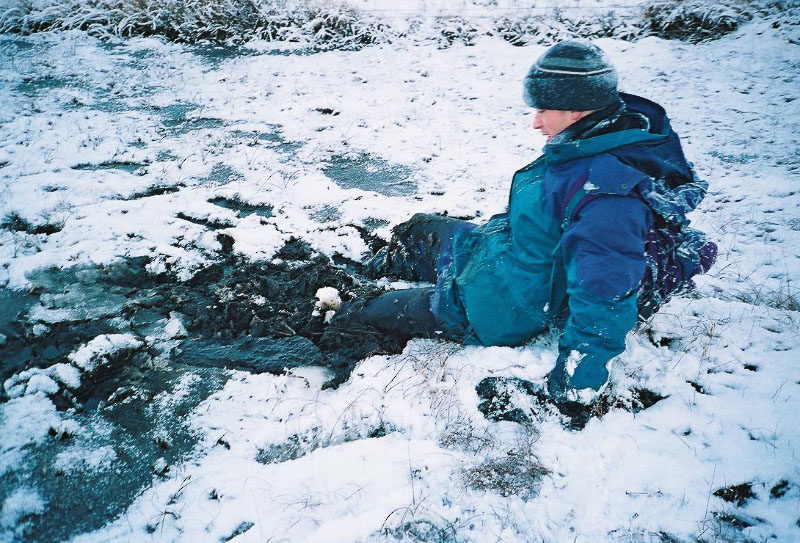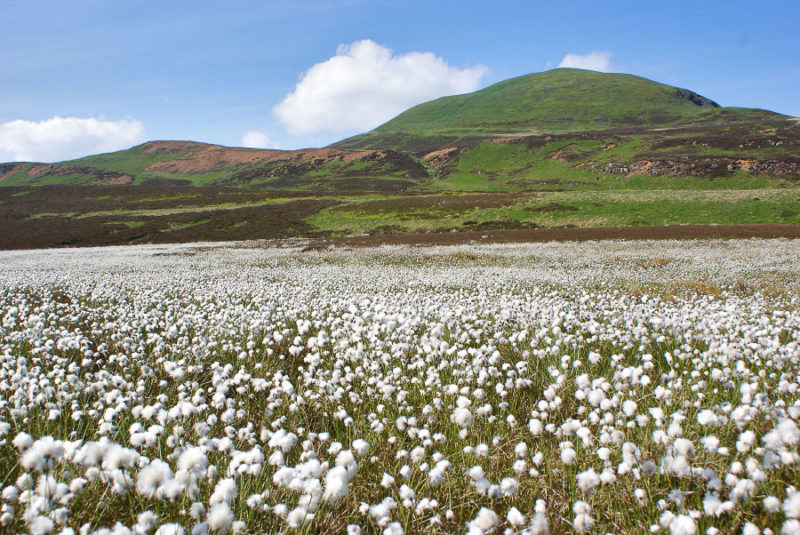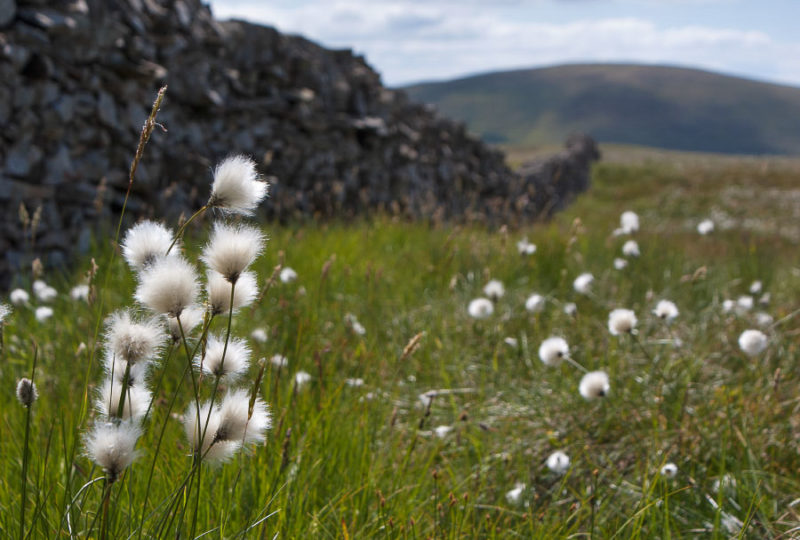
Faced with such bad press it’s not surprising that bogs can be viewed rather dimly. But give them a chance, because they can be transformed into the most beautiful and peaceful places in Scotland.

Bogs are hard to love, especially if it’s December 2004 and you’re my pal Andrew. And yes, I pulled him out AFTER I put my camera away.
That beauty isn’t necessarily evident all year round. But from late May and on into high summer, tufts of white start to appear about a foot above the ground, and many a Scottish bog takes on an appearance that I would be hard pushed to describe as anything other than exquisite.
In most places there may only be a small number of these tufts dotted here and there. In some places they may form more substantial stands that catch your eye from afar. And in a few select and very special places, they form a vast carpet that completely changes the appearance of the landscape around you.
This is the magic of cottongrass, a welcome addition to our soggy uplands, giving both texture and movement to an otherwise still landscape.

One of the highlights of the Scottish summer. Cottongrass, in the Lomond Hills of Fife.
Neither cotton nor grass
Like many a plant or animal, cottongrass has a descriptive but not entirely accurate name. Curiously it is neither cotton nor grass, though it admittedly looks somewhat like both. It is in fact a sedge, a group of plants that are closely related to the grasses.
Some folk might know it as ‘bog cotton’, and apparently it also goes by the name of ‘ghost grass’ in some places. But whichever you choose, all the names are used generically to describe a small group of similar cotton-like plants.
There are four species of cottongrass in the UK but only three of them are likely to be encountered in Scotland: Common Cottongrass, Broad-leaved Cottongrass and Hare’s-tail Cottongrass.
The first two look very similar, both having several ‘cotton’ heads drooping loosely from their stems. Those species tend to look like cotton wool that has been pulled apart. A bit unkempt. Hare’s tail, however, has just one ‘cotton’ head at the tip of its stem and thus has what I’d describe as a smarter, more upright appearance. The tuft is tidier, more spherical, and looks like it belongs on the tail end of a fluffy animal, which is presumably how it got the name ‘hare’s tail’ in the first place.
All three love damp, acidic environments so are well at home north of the border, but hare’s tail seems to be the one I encounter the most when out & about in the Scottish uplands.
The fine white hairs of cottongrass are attached to the sedge’s seeds. When the wind is strong enough, the hairs lift skyward and freely disperse on the breeze, ready to start life anew in a different part of the bog.

A smaller, more typical profusion of cottongrass. Ettrick Hills, 2010.
In the natural world, cottongrass is a valued food source for black grouse. The hens favour the flower heads, nibbling on them to improve their constitution prior to breeding. Cottongrass is also an important foodplant for the Large Heath butterfly, a bog specialist and an endangered species that lays its eggs on the sedges, and whose caterpillars subsequently feed on it.
Though it might not be cotton, it does have its uses to us too. It was used as candle wick back in the day and, of course, as a plant that thrives in waterlogged places, those white fluffballs are effective markers revealing to unsuspecting walkers the parts of the ground that might swallow their boots.
Softer than the plushest cat
I don’t mind admitting I have a supersoft spot for these small but delightful balls of fluff. As someone who reluctantly suffers the heat (yes, even in Scotland), humidity, insects and allergies of summer in eager anticipation of the onset of autumn and winter, cottongrass is one of the natural delights that helps nurse me through the warmer months.
First off, pure and simple, it’s a beauty! This does however hinge upon you encountering it on a nice dry day with a breeze, when its soft cotton-like strands are all fluffed up. It admittedly doesn’t have quite the same appeal when you encounter it on a blustery, drizzly day when it has all the matted appeal of a wet dog.
Aesthetically, much as I adore the Scottish uplands they can have a desert-like monotony to them, and stands of cottongrass are often a welcome relief to the uniformity. And, unlike many other things you might encounter on a walk through a Scottish bog, cottongrass is also very lovely to touch.
When I encounter cottongrass I can’t help but reach down and touch it, pulling it gently between my forefinger and middle finger where the skin is more sensitive, and enjoying the smooth, delicate feel of the fibres. I promise you, it’s more pleasurable than stroking the plushest of cats! Small wonder the material was once used to stuff pillows.
By both visual and tactile means, cottongrass has a strange ability to raise my spirits no end. And in the past few years I’ve discovered that the degree to which my spirits are raised is directly proportional to the concentration and profusion of the cottongrass. If one single lone head nodding in the breeze has the ability to make me smile, just imagine what an entire field of the stuff can do!
Hypnotised by a million golfballs
One of those select and very special places prone to an explosion of cottongrass can be found close to where I stay in the Lomond Hills. Not far from me is Glenvale, a cleft between Bishop Hill and West Lomond, a low pass that offers a route through the Lomond escarpment from Kinross-shire into Fife.
It’s a landscape of grass, typically a uniform shade of green or brown, punctuated by large areas of heather. It’s an area I know intimately, having moved here in 2010 and having since spent many an afternoon walking or biking through the hills.
Cottongrass is present in the boggy moorland on the Fife side of the glen every year, although it tends to be well scattered. Passing through, you’d not necessarily notice it as a feature in itself, as it’s usually just a few white spots on an otherwise brown landscape.
In 2013, however, something changed. I was up the nearby hill of East Lomond one evening and, looking west towards Glenvale, I could see that the entire glen between Bishop Hill and West Lomond was no longer brown like the rest of the landscape. It was white.
At first I thought it might simply be a trick of the light, reflecting off wet grass at the end of the day, but the next morning it was still there. I went on my bike to investigate and what I found was unprecedented in all my years of outdoorsiness.
As someone who spends a great deal of time in the damp Scottish uplands I’m well accustomed to seeing fairly sizeable stands of cottongrass. But whether it’s been in Sutherland or the Southern Uplands, those stands have always been of a size that you could walk through, from one side to another, in a couple of minutes at most.
This one, which stretched uninterrupted in every direction, would have taken a good ten minutes to cross from one side to the other. In stark contrast to previous years, the cottongrass was no longer just a pretty addition to an otherwise austere landscape. Instead it had become the dominant feature of that landscape, such that the ground was now white with brown spots, not vice versa. And because every single tiny tuft was moving in the breeze, it was as though the whole landscape was shimmering.
By now I was off my bike and just standing, gawping at the gobsmacking beauty of it all. As I usually do when I encounter cottongrass, I crouched down to get a closer look at the delicate fluffy heads. Doing so gives you an eye level perspective and sets it against the backdrop of whatever scenery you’re walking through. It’s always a nice angle for photographs.
Ordinarily the ground would be too wet to sit down on. It’s a bog, after all! However, given the abnormally dry conditions in the run up to summer 2013, the bog had started to dry out and it was possible to sit down amongst the cottongrass without getting a wet bum.
It was such a nice spot that after a few minutes I felt confident enough to lie down. It was early in the season, so the midges and other winged annoyances had yet to surface, and I could lie there without fear of being pestered or agitated. Lying on my side, propping myself up with my arm so that the cotton grass heads were at my eye level, I half dozed and daydreamed in the sunshine.
Curlews called off in the distance, meadow pipits chirped overhead, and kestrels hovered nearby. If there was a more beautiful spot in Scotland that day, I’d certainly never seen it.
It was one of those moments in the great Scottish outdoors when everything clicks into place. Weather, wildlife and worries (ie, lack of them). You feel relaxed, happy, have nowhere you need to be, and time just seems to melt away.
As a consequence I really don’t know how long I lay there dozing and daydreaming, but it was certainly much of the afternoon. I just couldn’t bring myself to leave. Perhaps it had something to do with the mesmerising movement of the little fluffy tufts around me. In the gentle breeze they rocked like clock pendulums, moving left, moving right, moving left, moving right. I think maybe I was gently hypnotised by a million nodding golf balls.
While I lay there I mulled over why that year in particular had produced such an astonishing profusion of cottongrass. The previous years and the following year, 2014, were almost devoid of it, so I wondered if it had something to do with the weather. 2012 as a whole was abnormally wet, and then the spring of 2013 was abnormally cold, with the Scottish winter persisting well into April. Might that have had something to do with it? Hmm.
Whatever the reason, I was extremely thankful. Of all the memorable outdoors experiences I’ve had in the Scottish countryside, that afternoon spent lying on a bog ranks as highly as any narrow ridge walks I’ve done in Torridon, any sun-kissed snowshoe excursions I’ve had on the Cairngorm plateau, or any close encounters I’ve had with eagles.
Mark my words, boggy is beautiful!


